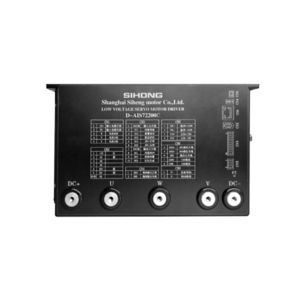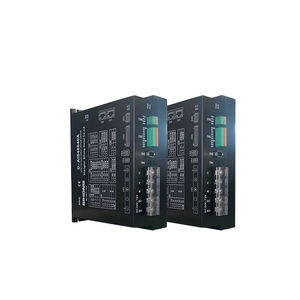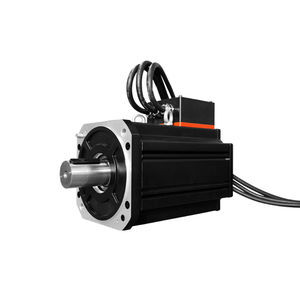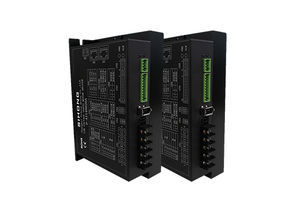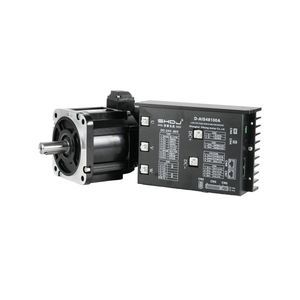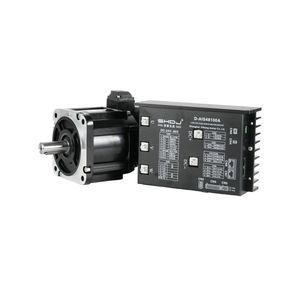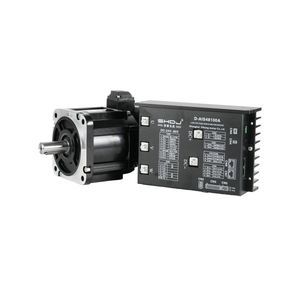
- Mecánica - Transmisión de potencia
- Motor y Control de Motor
- Servo-variador DC
- Shanghai Siheng Motor Co., Ltd
- Productos
- Catálogos
- News & Trends
- Ferias
Servo-variador DC D – AIS48100AModbusRS-48536-72 V
Añadir a mis favoritos
Añadir al comparador
Características
- AC DC
- DC
- Señal de salida
- RS-485, Modbus
- Voltaje
- 36-72 V
- Otras características
- compacto, de alta eficacia, programable, de 4 cuadrantes, inteligente, para aplicaciones móviles, inteligente, multifunción, para aplicaciones universales
- Intensidad
100 A
Descripción
Product DetailsFeatures high stability, high positioning accuracy, high motor response, low noise, low heat generation, well-structured design, strong overload capacity, practical and rich functions, and simple and convenient application. It has protections against over-voltage, under-voltage, overspeed, overcurrent, overload, encoder anomalies, position deviation, stop, parameter anomalies, etc.Technical SpecificationsDrive ModelVoltage Range (V)Rated Current (A)D – AIS24008A24 – 368D – AIS48015A24 – 4815D – AIS48025A24 – 6025D – AIS48050A24 – 7250D – AIS48100A36 – 72100D – AIS72200A48 – 96200D – AIS72300A48 – 96300Control Method① Position control ② Speed control ③ Torque control ④ Communication controlControl FeaturesSpeed frequency response: ≥200Hz, Pulse frequency received ≤200kHz, Speed fluctuation rate: < ±0.03 (Load 0 – 100%): < ±0.02×(0.9 – 1.1) Power supply voltageMonitoring FunctionCurrent speed, DI input, DO output, Current position, Command input pulse accumulation, Average load rate, Position deviation count, Motor phase current, Bus voltage value, Module temperature, Alarm log, Command pulse frequency corresponding speed, Operating status, etc.Home – return function13 types of standalone (search) home – return modes, and home – point compensation functionRs485 FunctionFollows standard Modbus – RTU protocol, One-to-two two-way communication interface for easy networking and parallel connectionController Installation DimensionsProduct model: D – AIS48100ARated voltage: 36 – 72VRated current: 100ASplit-type Drive Hardware InterfaceApplicable drive models: D – AISXX005A / D – AISXX0015A / D – AISXX0025A / D – AISXX0040A / D – AISXX00100A / D – AISXX00200ASplit-type AI MOTOR Drive Interface DiagramSerial No.SymbolFunctionRemarksCn11UMotor U-phaseJVW power cable interface for motor adaptation.2VMotor V-phase3WMotor W-phase4DC–Negative pole of input power supply.External DC input power supply must distinguish positive and negative poles; voltage range: DC48V5DC+Positive pole of input power supply.Cn215V+Motor encoder power interfacePower interface for adapting the motor encoder.2GNDPower interface3NCEmpty terminalNo function4NCEmpty terminalNo function5SD+Motor encoder communication interfaceCommunication interface for adapting the motor encoder.6SD–CN31DI–COMCommon terminal for input signals.Common terminal for all DI input signals. When DI–COM is connected to the positive pole, negative DI control is effective; when EN–COM is connected to the negative pole, positive DI control is effective.2DI1Input signal terminal 1Factory default function: servo enable3DI2Input signal terminal 2Factory default function: alarm reset4DI3Input signal terminal 3Factory default function: emergency stop5DI4Input signal terminal 4Factory default function: JOG positive jog6DI5Input signal terminal 5Factory default function: JOG negative jog7DO–COMCommon terminal for output signals.Common terminal for all DO output signals. When DO–COM is connected to the positive pole, positive DO action output is effective; when DO–COM is connected to the negative pole, negative DO action output is effective.8DO1Output signal terminal 1Factory default function: servo ready9DO2Output signal terminal 2Factory default function: fault alarm output10DO3Output signal terminal 3Factory default function: positioning completion outputCN41BRK+Brake output positive pole.Interface for adapting the motor mechanical brake (brake)2BRK–Brake output negative pole.Reference Table for External Braking Resistor Specification for Split-type Unit CN9 InterfaceSplit-type Drive ModelRated Output CurrentRequired Resistance Value of External Braking ResistorRequired Power of External Braking ResistorD – AISXX008A8A10 ohms – 30 ohms rangeOver 100WD – AISXX0015A15A10 ohms – 30 ohms rangeOver 100WD – AISXX0025A25A10 ohms – 30 ohms rangeOver 100WD – AISXX0050A50A5 ohms – 15 ohms rangeOver 200WD – AISXX00100A100A5 ohms – 15 ohms rangeOver 200WD – AISXX00200A200A5 ohms – 15 ohms rangeOver 200WStandard Wiring DiagramInput Power Supply WiringNote 1: The input power supply terminals must strictly distinguish positive and negative poles. The input power supply voltage range may vary depending on the model. Refer to the hardware interface reference wiring for the corresponding model in the previous chapter.Note 2: This product has a certain overload capacity. When selecting an external switching power supply, the output capacity should be 1.5 times the rated current of this product. The product's rated current is indicated on the nameplate.Pulse Speed Signal WiringCollector – Open WiringDifferential Signal WiringNote 1: For different motors, the positions of the pulse input terminal interfaces may vary. Refer to the hardware interface description for the corresponding model in the previous chapter.Note 2: This product supports pulse input with a wide voltage range of 5 – 24V, and the maximum received pulse frequency is 200KHZ. The upper-level pulse device should pay attention to limiting the frequency to 200K to avoid the driver easily losing pulses and causing positioning anomalies.Note 3: It is recommended to use double-shielded cables for pulse control lines and avoid placing them in the same circuit as strong current cables – strong interference sources, which can effectively protect against strong external magnetic interference.Note 4: The above pulse connection methods must be consistent with H05–15 parameters. The factory default for H05–15 is pulse + direction command mode.DI and DO Terminal WiringAT Input Terminal WiringNote 1: The control voltage of the input terminals is valid at DC12–24V.Note 2: Each DI can be freely assigned different functions (refer to section 4.2 DIDO parameter section), but the same function cannot be assigned to multiple DIs.Note 3: For external switch signal control with DC– input, select the NPN-type connection method, where low level is effective; for external switch signal control with DC+ input, select the PNP-type connection method, where high level is effective.DO Output Terminal WiringNote 1: The maximum drive capacity of the output terminals is <300mA current. If a large load needs to be driven, a relay should be used for conversion.Note 2: Each DO can be freely assigned different functions (refer to section 4.2 DIDO parameter section).Note 3: When controlling the DO port action, if DC– is output, select the NPN-type connection method, where low-level output is effective; if DC+ is output, select the PNP-type connection method, where high-level output is effective.RS485 Communication WiringMulti-slave ConnectionNote 1: For multi-slave connection, if the communication signal noise is large, it is recommended to add a 120-ohm terminal resistor to the last slave to ensure communication quality.Note 2: For communication-related content, refer to (section 4.5 RS485-related parameters).Host Computer Debugging ConnectionNote 1: Generally, a computer does not have a direct 485 interface, and a USB-to-485 converter is required to connect to the slave motor driver.Note 2: The host computer debugging software for PC can be downloaded from the official website of our company, which is convenient for users to debug.Technical characteristics / specificationsModel: D – AIS48100ARated voltage: 36 – 72VRated current: 100AControl methods: Position, speed, torque, communicationSpeed frequency response: ≥200HzPulse frequency received: ≤200kHzProtections: Over-voltage, under-voltage, overspeed, overcurrent, overload, encoder anomalies, position deviation, stop, parameter anomaliesRS485 Modbus RTU communication
Otros productos de Shanghai Siheng Motor Co., Ltd
Servomotor y controlador de CC divididos
Búsquedas asociadas
- Motor eléctrico
- Motor de vehículo
- Motor de corriente continua
- Motor AC
- Motor síncrono
- Motorreductor eléctrico
- Motor para aplicaciones industriales
- Motorreductor CC
- Motor BLDC
- Motor 24 V
- Motorreductor eléctrico industrial
- Motorreductor eléctrico coaxial
- Motorreductor eléctrico planetario
- Servo-amplificador
- Servomotor eléctrico
- Motorreductor angular
- Motorreductor eléctrico AC
- Motor paso a paso
- Motor 220V
- Servomotor AC
* Los precios no incluyen impuestos, gastos de entrega ni derechos de exportación. Tampoco incluyen gastos de instalación o de puesta en marcha. Los precios se dan a título indicativo y pueden cambiar en función del país, del coste de las materias primas y de los tipos de cambio.



